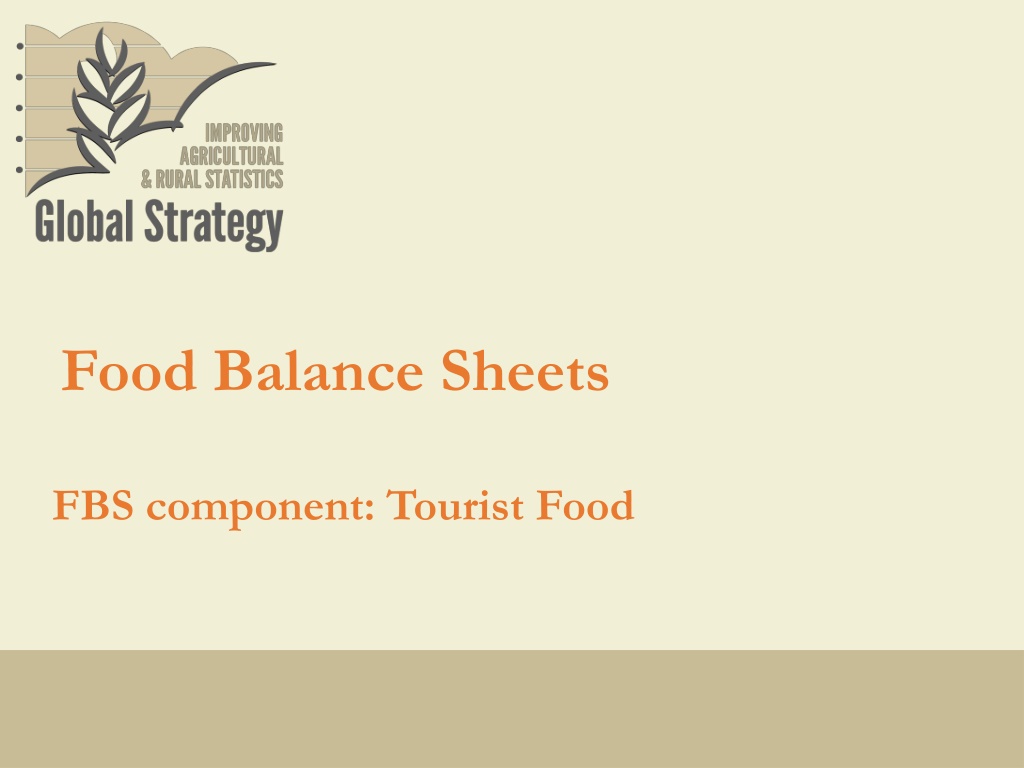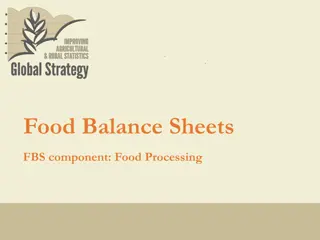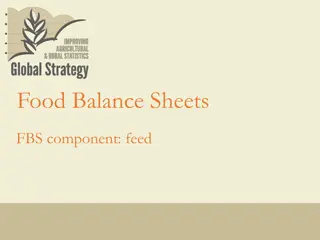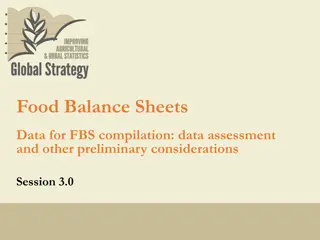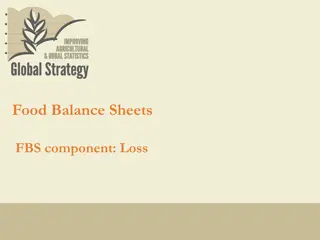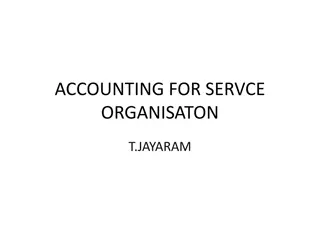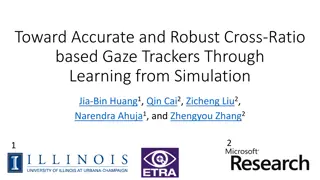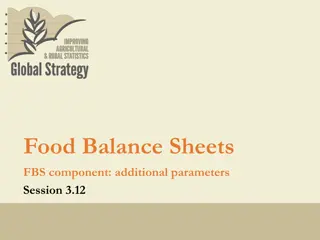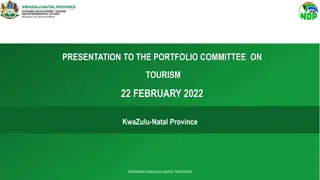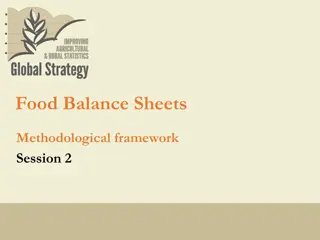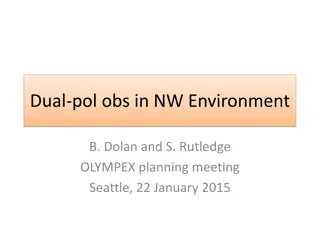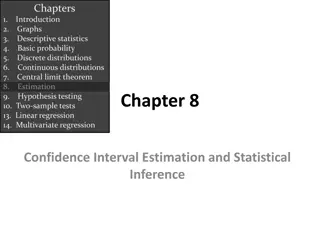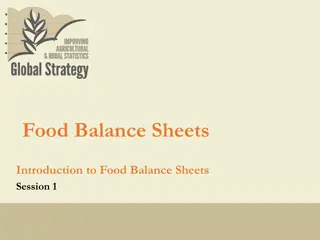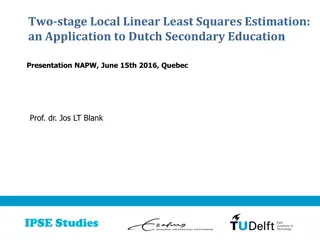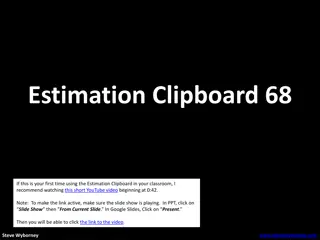Understanding Tourist Food in Food Balance Sheets: Data, Sources, and Estimation
Explore the concept of Tourist Food in Food Balance Sheets (FBS) focusing on data sources, definitions, and estimation methods. Learn why it's crucial to account for Tourist Food separately, access different data sources such as national tourism offices and UN reports, and understand the process of estimating Tourist Food. This session equips you with knowledge on how countries can effectively capture and interpret Tourist Food in their FBS.
Download Presentation

Please find below an Image/Link to download the presentation.
The content on the website is provided AS IS for your information and personal use only. It may not be sold, licensed, or shared on other websites without obtaining consent from the author. Download presentation by click this link. If you encounter any issues during the download, it is possible that the publisher has removed the file from their server.
E N D
Presentation Transcript
Food Balance Sheets FBS component: Tourist Food
Learning Objectives At the end of this session, the audience will know: a) Different data sources for tourist food b) Recommended approach for estimating tourist food 2
Outline 1. Definitions 2. Data sources 3. Imputation and Estimation 3 3
Definitions 4 4
Definition Tourist Food refers to food that is consumed by non-resident visitors to a given country during the course of their stay. This variable is expressed in net terms in the food balance sheets (as in, consumption of incoming tourists minus consumption of residents as tourists in other countries). Countries with negligible numbers of visitors may choose not to estimate Tourist Food as a separate FBS component. Instead, Tourist Food can be captured in other residual uses 5 5
Definition Why tourist food as separate category? Estimating Tourist Food independently is encouraged for two reasons. Data on tourist arrivals is widely accessible, such that it is possible for all countries to more specifically account for Tourist Food in their food balance sheets. 1streason For some countries particularly Small Island States large quantities of tourists relative to the resident population have the potential to substantially alter the balance sheet landscape 2ndreason 6 6
Data sources 7 7
Data sources Official data sources National tourism offices: it is likely that national tourism offices in each country will be the entity that publishes the most detailed information available on tourist arrivals and departures Through surveys: tourism boards may also publish figures on Tourist Food patterns, which would certainly aid FBS compilers in estimating Tourist Food within the balance sheets. 8 8
Data sources Alternative data sources reports from the UN World Tourism Organization (UNWTO): If FBS compilers do not have ready access to their country s data on tourist arrivals, they may instead consult reports from the UN World Tourism Organization (UNWTO). This organization compiles and publishes member country-provided data on the number of visitors, average length of stay, and country of origin, as well as estimates on outbound tourism. See http://www.eunwto.org/toc/unwtotfb/current. 9 9
Imputation and estimation 10 10
Imputation and estimation The approach to imputing Tourist Food is merely a calculation and not an econometric model. Net Tourist Food is simply the amount of food consumed by incoming tourists minus the amount of food that would have been consumed by residents had they been present in the country. NetTC=[#Incoming tourist days*Daily food consumed by tourists]- [#Outgoing tourist days*Daily food not consumed by residents] 11 11
Imputation and estimation Calculations calculation of the number of tourist days, N, for travelers originating from country l and visiting country j, ??? ???= ????+ ???? ? ????=the number of day visitors from l to j ????=the number of overnight visitors from l to j ?=the average number of days an overnight visitor stayed 12 12
Imputation and estimation Simplified representation of net tourism in Country J K K J J L L Flow of country j s residents travel to visit country k, ??? Flow of tourists from country l visit country j, ??? How to calculate net tourism consumption in this three-country scenario? 13 13
Imputation and estimation In this three-country scenario, for any individual commodity i, net Tourist Food for country j (NetTCij) is given by: ???????= ??????? ??????? ???????=The amounts of food consumed by tourists in MT for incoming tourists ???????= The amounts of food consumed by tourists in MT for outgoing tourists How to calculate ???????and ???????? 14 14
Imputation and estimation How to calculate ???????and ???????? o The amounts of food consumed by tourists in MT (Foodiljor Foodijk) is calculated as the product of the amount of tourist-days N and the number of calories consumed daily, divided by the amount of calories per MT for commodity I o But according to assumptions relative to incoming tourists ,formula of Foodiljor Foodijk differ 15 15
Imputation and estimation C?????????? ?? ??????? Assumptions Tourists will eat local foods, but at a scale that accounts for their own typical daily caloric consumption Tourists are limited in their food choices to what is on offer locally tourists are likely to consume the same overall amount of food that they would eat at home 16 16
Imputation and estimation C?????????? ?? ??????? Formula ???? ???? ??? ??? ???????= ???? ?? Nlj=the number of tourist-days for tourists traveling from country l to country j, fij=the amount of calories of commodity i consumed in country j, ???? ????=relative amount of total calories consumed historically in country l compared to country j, ???? ??is the number of calories contained in one MT of commodity i 17 17
Imputation and estimation C?????????? ?? ??????? o purpose of accounting for outbound tourists is to subtract what they would have eaten at home not to detail exactly what they will eat while abroad ???? ???? o No scaling factor Formula ???????=(??? ???) ???? ?? o Njk=the number of tourist-days for country j s residents travel to visit country k, o fij=the amount of calories of commodity i consumed in country j, ???? ??is the number of calories contained in one MT of commodity i o 18 18
Imputation and estimation Comprehensive representation of net tourism flows for country J O O K K M M L L J J N N P P World 19 19
Imputation and estimation net Tourist Food for country j (NetTCij) for any individual commodity i ??? ??? ???? ? ?=?,? ? ? ???? ?=?,? ? ??? ??? ???? ?? ???????= ???? ?? Food consumed by incoming tourists Food consumed by outgoing tourists 20 20
Imputation and estimation Exercise FBS compilers in country j are estimating inbound Tourist Food of beer of barley. Let s assume that country j is the relatively poorer country with daily DES of 2,000 kcal/cap/day ( ????), and country l is the wealthy country where DES ( ????) is 3,500 kcal/cap/day. Tourists from Country l spend 50,000 tourist-days in country j in the reference period. In addition, in country j, daily consumption of beer of barley, f, is 25 kcal/cap/day, and consulting a calorie conversion table, they find that there are approximately 430 calories per kilogram of beer of barley equivalent to 430,000 calories per MT of beer of barley. Using this information, compute the daily calories of beer of barley consumed by tourists from country l to country j ? 21 21
Imputation and estimation Correction C?????????? ?? ??????? Formula ???? ???? ??? ??? ???????= ???? ?? Nlj=the number of tourist-days for tourists traveling from country l to country j, fij=the amount of calories of commodity i consumed in country j, ???? ????=relative amount of total calories consumed historically in country l compared to country j, ???? ??is the number of calories contained in one MT of commodity i 22 22
Imputation and estimation Correction ????=2,000 kcal/cap/day ????=3,500 kcal/cap/day. Nlj= 50,000 fij= 25 kcal/cap/day ???? ??=430,000 ???? ???? ??? ?????? ??????????= ??????? ?? 50,000 25 3500 ???????? 2000 ??????????= 430,000???????? ?? -?????????? = 5.09 MT/Year 23 23
References 3rdchapter of the guideline: Data for FBS compilation: considerations, sources and imputation , 3.5.8 Tourist Food Appendix 1: Tourist Food 24 24
